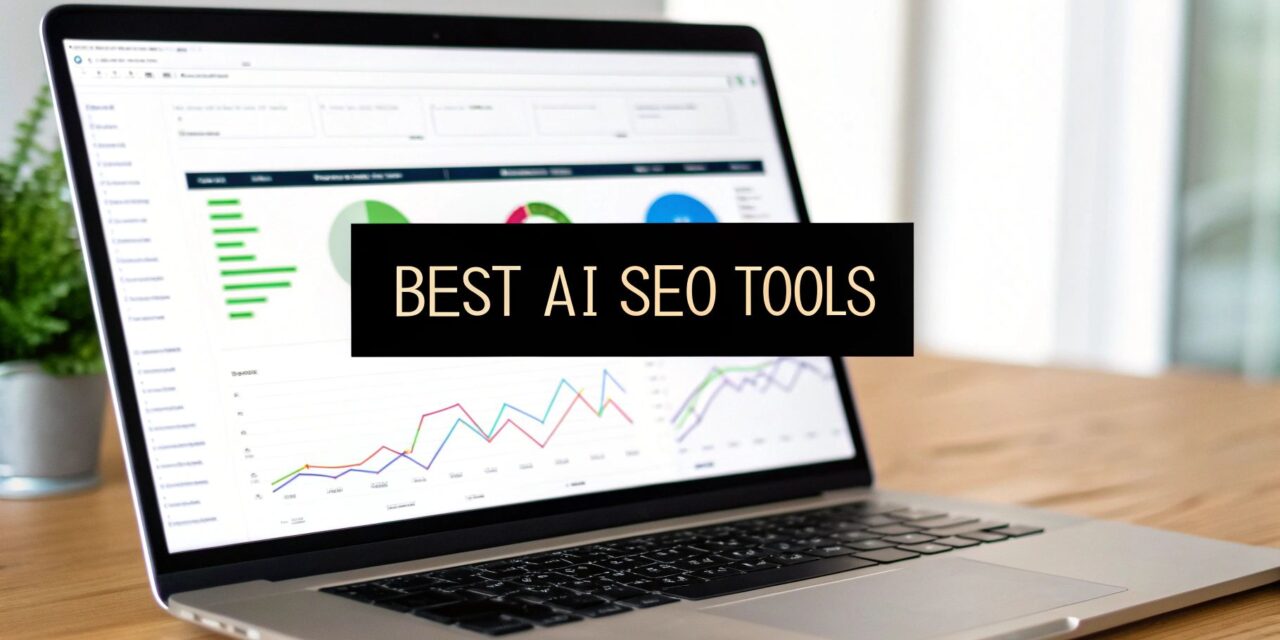Hey there! Stepping into the world of search engine optimization can feel a bit like trying to solve a giant, ever-changing puzzle. Between endless keyword research, analyzing what your competitors are up to, crafting perfectly optimized content, and fixing those pesky technical glitches, the to-do list is massive. If you're a solo entrepreneur or part of a small team, it can be downright overwhelming. This is where artificial intelligence comes in to save the day, turning tedious manual tasks into smart, automated workflows. AI-powered tools aren't just a cool new thing anymore; they're pretty much essential for getting ahead, scaling up your content, and finding those golden insights you might have otherwise missed.
This guide is designed to cut through the noise and help you find the best AI SEO tools that actually fit what you need. Whether you're aiming to generate high-ranking blog posts, give your existing pages a boost, automate technical check-ups, or build a smarter backlink strategy, the right platform can be a total game-changer. We've dug past the marketing hype to give you a real, honest breakdown of the top solutions out there.
Inside, you’ll find a detailed analysis of each tool, complete with:
- Practical Use Cases: Discover exactly how to apply each tool to real-world SEO challenges.
- Key Features & Limitations: An honest look at what each platform does well and where it falls short.
- Pricing Breakdowns: Clear information to help you find a tool that fits your budget.
- Ideal User Profiles: We'll tell you if a tool is better suited for freelancers, agencies, or in-house marketing teams.
We’ve included direct links and screenshots for every platform, making it easy for you to explore and compare your options. Forget guesswork. Let's find the perfect AI tool to streamline your SEO efforts and start driving meaningful results.
1. Semrush
Semrush is a giant in the SEO world, but it's also one of the best AI SEO tools for anyone who loves having everything in one place. It's awesome because it blends its classic, powerful features—like keyword research and backlink analysis—with a super smart suite of AI content tools. This all-in-one approach means you can go from analyzing data to creating and optimizing content without ever having to switch tabs. It's a huge favorite for agencies and marketing teams for this very reason.
The platform's real magic lies in its interconnected Content Marketing Toolkit. You can use its ContentShake AI to brainstorm content ideas, create detailed outlines, and even draft whole articles based on your keywords. What's so special about this? It pulls data directly from Semrush's massive SEO database, ensuring your AI-generated content is strategically on point from the get-go.
Key Features & User Experience
Semrush gives you a few different ways to use its AI, which is handy. The SEO Writing Assistant, which you can get as a Google Docs or WordPress plugin, gives you real-time feedback as you write, suggesting AI-powered tweaks and improvements. For example, as you're writing a blog post, it might pop up and suggest you add a specific keyword or rephrase a sentence to improve readability, right inside your document.
Expert Opinion: SEO consultant Miranda Miller notes, "The real power of Semrush's AI is how it's baked into the workflow. Start your process with the Keyword Magic Tool to find low-competition keywords. Then, feed those directly into the ContentShake AI to generate a brief. This ensures your AI content is built on a solid foundation of data-driven SEO strategy."
The user interface is packed with data and can feel a little intense for total beginners, but its logical layout is really rewarding once you get the hang of it.
Pros and Cons
- Pro: A true all-in-one toolchain that covers the entire SEO and content lifecycle.
- Pro: Multiple AI integrations (in-app tools, browser extensions, editor plugins) offer flexibility.
- Con: The most powerful AI features are locked behind higher-tier plans and add-on toolkits.
- Con: The cost can quickly escalate for larger teams needing multiple user seats and full feature access.
Pricing and Access
Semrush offers several pricing tiers, starting with the Pro plan. However, to unlock the full suite of AI content tools like ContentShake AI, you'll need the Guru plan or higher, or to purchase the Content Marketing Platform as an add-on. This makes it a significant investment best suited for serious marketers and businesses. Exploring these tools is a great way to understand how to use AI for marketing in a professional context.
Website: https://www.semrush.com
2. Surfer
Surfer carves out its spot among the best AI SEO tools by focusing like a laser on data-driven, on-page content optimization. Instead of trying to do everything, Surfer gives you a clear, focused workflow for creating and checking content to make sure it aligns perfectly with what's already ranking high on Google. It analyzes the top competitors for your target keyword and hands you an actionable roadmap for your content's structure, keyword usage, and overall topic coverage.
This SERP-informed approach is its secret sauce. The Content Editor gives you a real-time score as you write, suggesting specific terms and phrases to include based on its analysis. For instance, if you're writing about "best dog food for puppies," it might tell you to add terms like "grain-free," "high protein," and "digestive health" to compete with the top articles. This takes the guesswork out of on-page SEO, making it a must-have for content writers who need to produce competitive articles at scale. A cool, unique feature is its AI Tracker, which helps you see how your brand is showing up in new AI search results, like ChatGPT and Google’s AI Overviews.
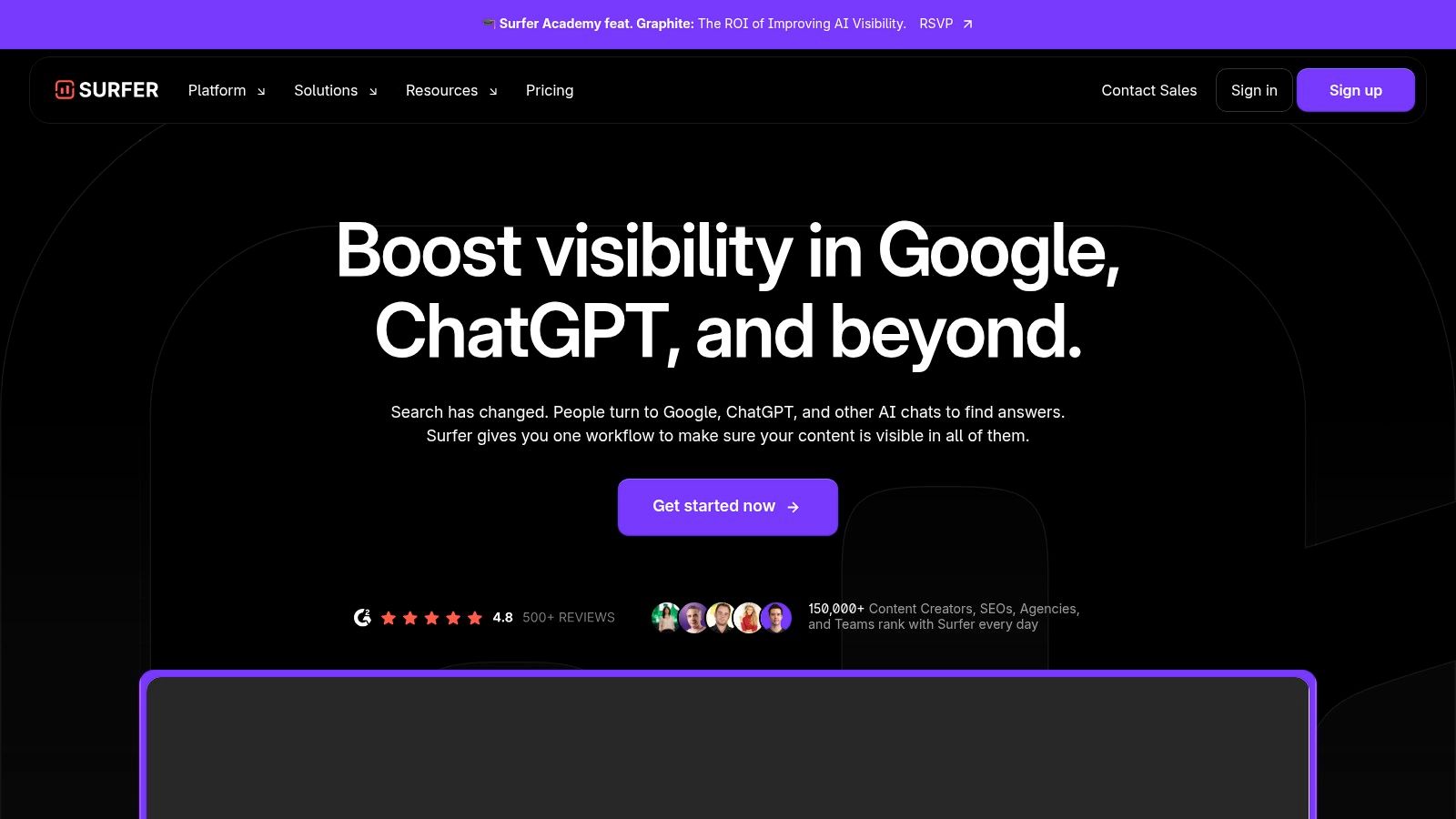
Key Features & User Experience
Surfer’s main workflow revolves around its Content Editor, which is clean, intuitive, and gives you instant feedback. You can generate entire articles with its AI writer or use it to optimize existing content. It also offers tools to help you map out your content strategy and build authority around key topics.
Expert Opinion: "New Surfer users often get obsessed with hitting a perfect 100/100 score," says content strategist Ben Taylor. "But I always tell my team: use the SERP analysis outline and competitor data to inform your structure first. A well-structured article that hits a score of 80 will often outperform a poorly structured one that scores 95."
The user interface is super beginner-friendly, walking you through the process of setting up your query and getting your editor or audit ready.
Pros and Cons
- Pro: Excellent, practical on-page guidance based on real-time SERP data.
- Pro: The dedicated AI Tracker is forward-thinking, preparing users for the future of search.
- Con: Managing credits, user seats, and add-on features can make costs unpredictable and complex.
- Con: The distinction between legacy plans and current offerings can be confusing for existing users.
Pricing and Access
Surfer operates on a subscription model with various tiers that offer a set number of Content Editor credits, audits, and AI article credits per month. Key features like the AI Tracker are often sold as separate add-ons. This structure makes it scalable, but businesses should carefully evaluate their monthly usage to choose the right plan and avoid unexpected overage costs.
Website: https://surferseo.com
3. Clearscope
Clearscope is a premium content optimization tool that has earned its reputation as one of the best AI SEO tools by focusing on semantic relevance and user intent. Think of it less as an all-in-one toolbox and more as a specialist that excels at one critical thing: making sure your content comprehensively covers a topic in the way search engines and readers expect. It uses Natural Language Processing (NLP) to analyze top-ranking content and gives you a precise, actionable roadmap for your writers.
This makes it a go-to for content teams who care more about quality and editorial excellence than just pumping out tons of articles. Clearscope perfectly bridges the gap between data-driven SEO strategy and the creative writing process, offering guidance that feels like you have a subject-matter expert looking over your shoulder. It’s a favorite among teams that want to write the best, most helpful content on the web.
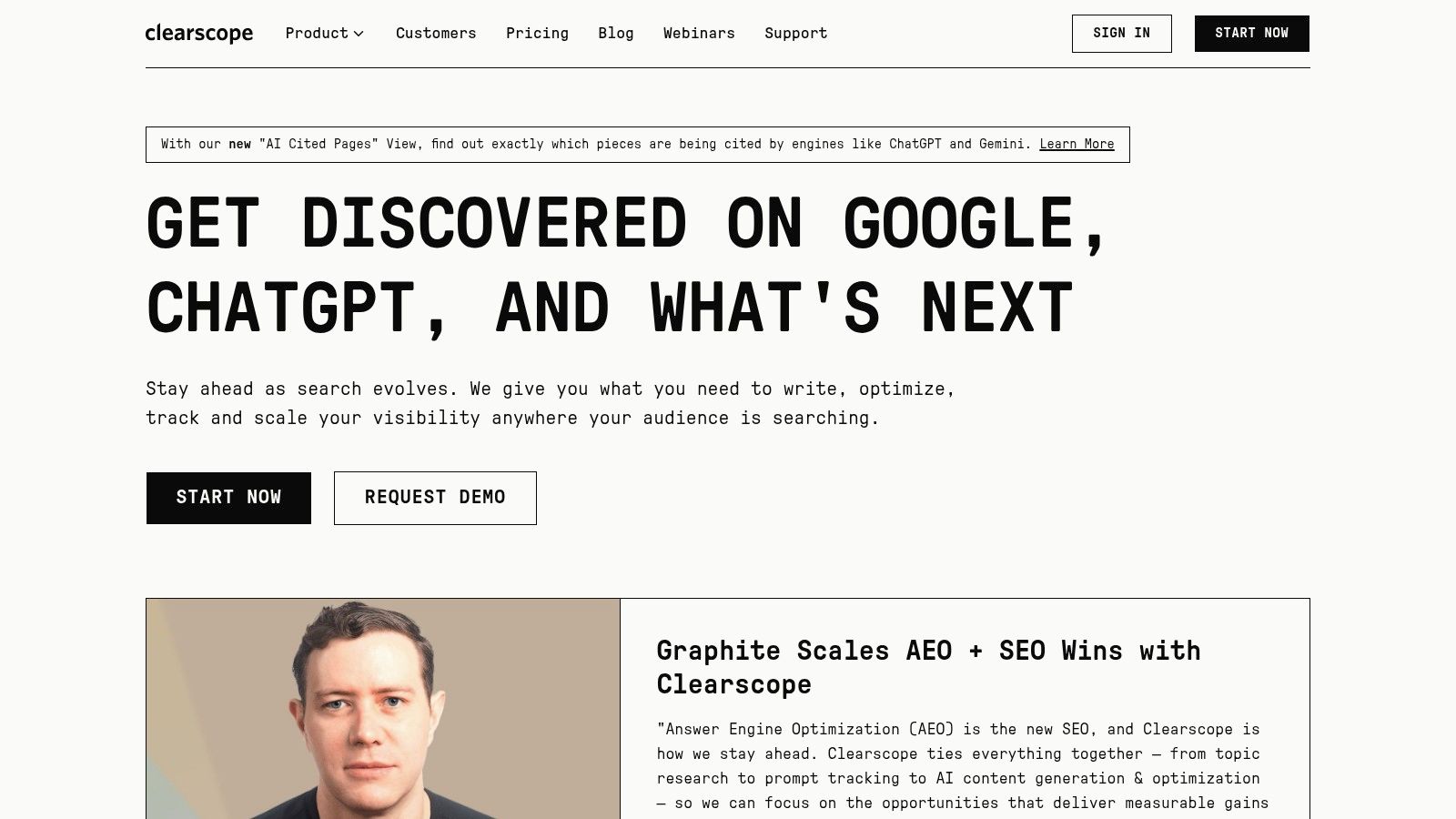
Key Features & User Experience
Clearscope's main feature is its Content Editor, which grades your draft in real-time and gives you a list of related terms to include. The interface is clean and super intuitive, so writers can pick it up without a steep learning curve. Plus, it integrates with Google Docs and WordPress, so teams can get its powerful insights right where they're already working.
Expert Opinion: According to Andy Crestodina, a leading content marketing expert, "You shouldn't chase a perfect A+ score at the expense of readability. Use Clearscope’s term suggestions as a guide to cover important sub-topics and entities, but always prioritize writing naturally for your human audience first. The goal is helpfulness, not just a high score."
The platform also provides powerful content brief generation and now includes monitoring for AI visibility (AEO), helping you understand how your content appears in AI-driven search experiences.
Pros and Cons
- Pro: Highly usable and editorially friendly guidance that empowers writers, not just SEOs.
- Pro: Excellent at analyzing and mapping search intent and semantic context for a topic.
- Con: The credit-based system can become expensive, especially for high-volume content agencies.
- Con: It's a specialized tool, lacking the broad keyword research or technical SEO features of a full suite.
Pricing and Access
Clearscope operates on a tiered, credit-based model where one "report" credit is used to analyze a target keyword. Plans start with the Essentials tier, which is great for small businesses and freelancers. Larger teams and agencies will need to look at the Business or Enterprise plans to get enough report credits and user seats. While it's a significant investment, its ability to improve content quality often provides a clear return.
Website: https://www.clearscope.io
4. MarketMuse
MarketMuse stands out among the best AI SEO tools by acting like a true content strategist. Instead of just helping you write content, it gives you a strategic blueprint for what you should write, how to link it all together, and how to measure your expertise on any given topic. This makes it perfect for teams who want to move beyond writing random articles and instead build a comprehensive library of content that establishes them as the leaders in their industry.
The platform is fantastic at analyzing your entire website to find content gaps and new opportunities. It uses AI to map out topics and show you exactly where your authority is weak. Then, it generates incredibly detailed content briefs based on this analysis, guiding writers on what subtopics, entities, and questions to cover to create truly comprehensive pieces. For example, it might analyze your SaaS blog and point out that you've written a lot about "project management" but have zero content on "agile methodologies," a critical gap.
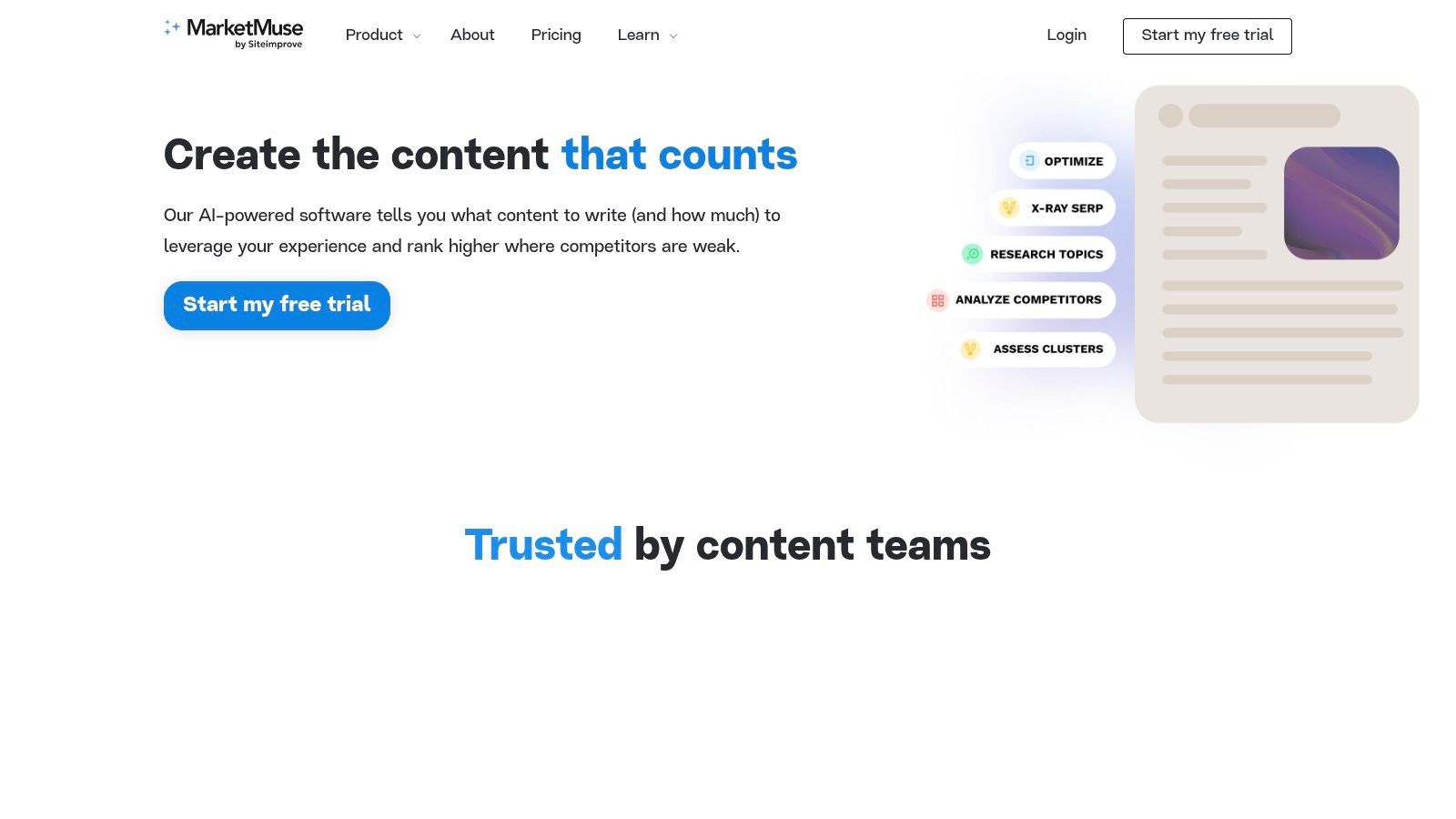
Key Features & User Experience
MarketMuse’s power lies in its automated content inventories and AI-driven research. You can literally see your content clusters on a map and know at a glance where you need to build more depth. The platform offers different types of briefs tailored to specific needs—like local content, product comparisons, or detailed FAQs—ensuring your AI-powered strategy is versatile.
Expert Opinion: Content strategist Ross Hudgens advises, "Use the 'Content Inventory' feature first to get a baseline of your site's topical authority. Then, use the 'Connect' tool to find internal linking opportunities to instantly boost the perceived authority of new and existing pages. It’s one of the fastest ways to show Google your expertise."
While the interface is powerful, it's definitely geared toward strategists and can have a steep learning curve for those new to topic modeling.
Pros and Cons
- Pro: Excellent for strategic planning, identifying content gaps, and scaling topical authority.
- Pro: Generates highly specific and useful briefs for different content formats.
- Con: The platform is heavily enterprise-focused, and public pricing can be opaque.
- Con: Requires a commitment to learning its methodology to unlock its full potential.
Pricing and Access
MarketMuse offers several tiers, including a limited Free plan that is great for exploring its core concepts. Paid plans like the Standard and Premium tiers unlock more queries, content briefs, and strategic planning features. The pricing structure is designed for serious content teams and businesses that are investing heavily in becoming the go-to resource in their niche.
Website: https://www.marketmuse.com
5. Frase
Frase shines as one of the best AI SEO tools for content creators who love an efficient, all-in-one workflow. It smoothly guides you from researching the SERPs to generating a content brief, writing with AI, and optimizing your page. This integrated approach saves you from juggling a bunch of different tools, letting you focus on creating content that's designed to rank right from the start. It’s perfect for people who want to get from idea to optimized draft, fast.
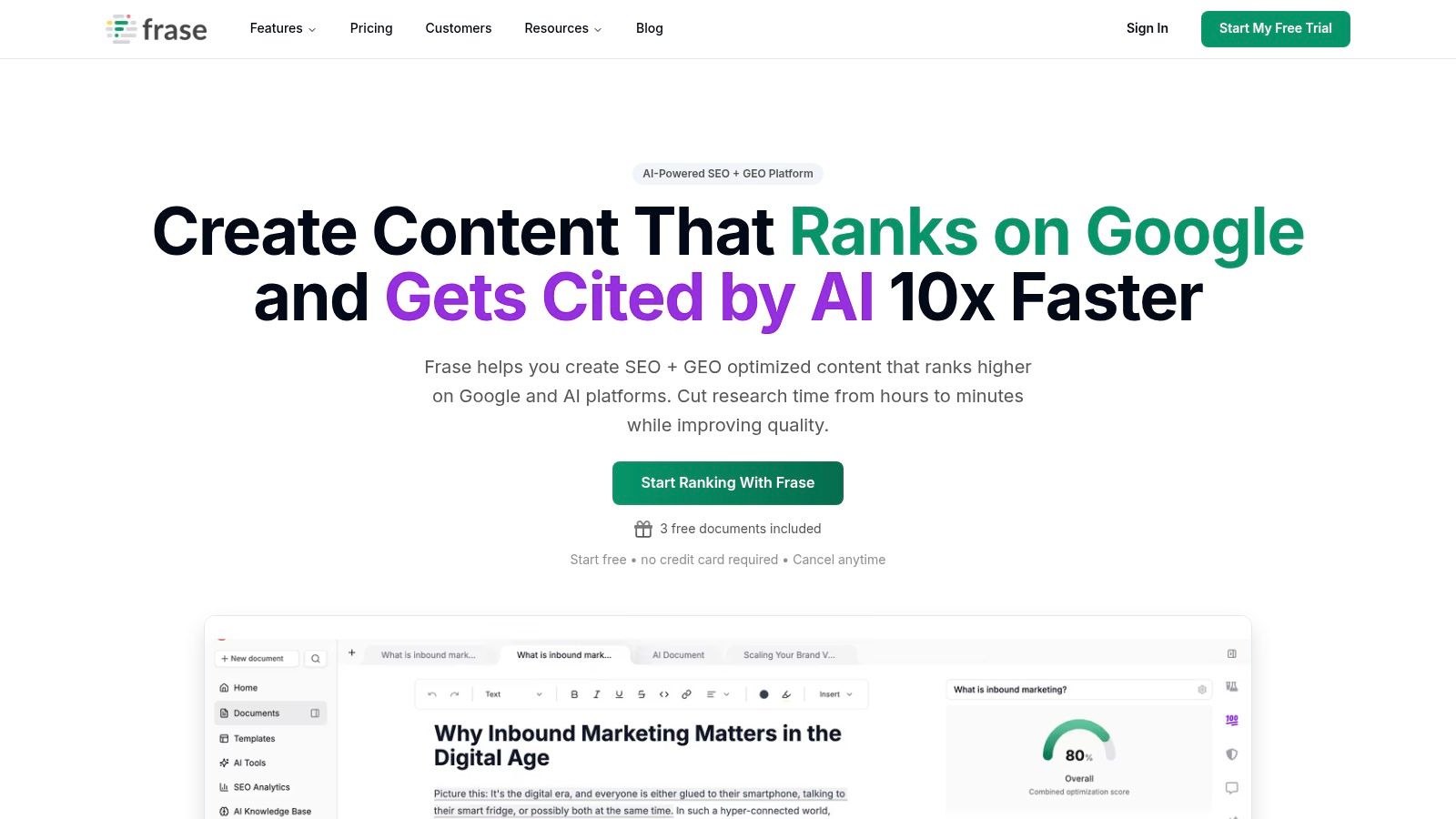
The platform's standout feature is its powerful content brief generator. With a single click, it analyzes the top search results for your target keyword and pulls together a detailed outline, including common headings, questions people are asking, and topics you need to cover. For example, if your keyword is "how to start a podcast," it will instantly generate a brief with sections like "Choosing Your Niche," "Essential Equipment," and "Recording and Editing Software," all based on what's already ranking. This data-driven foundation ensures your content is comprehensive and hits all the right notes for user intent.
Key Features & User Experience
Frase presents its tools in a clear, step-by-step interface that's super welcoming for beginners. The workflow is logical: you research a topic, build a brief, write with AI assistance, and then optimize against a real-time content score. The platform also offers unique 'Rank-Ready' documents, allowing you to buy fully optimized articles on a pay-as-you-go basis, which is a cool, flexible option.
Expert Opinion: "Here's a pro tip for Frase users," suggests SEO blogger Alex Thompson. "After generating your brief, switch to the 'Optimize' tab and paste in your competitor's content. This gives you an instant benchmark score to beat and reveals specific terms and topics you can add to outperform them. It’s like getting a cheat sheet."
The user experience is clean and focused, avoiding the data overload that can plague more complex platforms.
Pros and Cons
- Pro: A streamlined workflow that covers research, briefing, writing, and optimization in one place.
- Pro: Flexible entry-level pricing and the option to buy optimized drafts without a full subscription.
- Con: Project and AI credit caps on lower-tier plans may require careful management or upgrades for high-volume users.
- Con: Lacks the deep technical SEO and backlink analysis tools found in all-in-one suites like Semrush or Ahrefs.
Pricing and Access
Frase offers several plans, starting with a Solo tier designed for individuals. The real power unlocks with the Basic and Team plans, which provide more document credits and user seats. Its unique value proposition is the ability to purchase professionally optimized articles, which makes it a flexible option for teams needing to scale content without committing to higher subscription costs. Frase is one of the top AI tools for content creation that balances cost and functionality effectively.
Website: https://www.frase.io
6. Jasper
Jasper has grown from a popular AI writer into a full-on AI marketing platform, making it one of the best AI SEO tools for teams who need strong control over their brand consistency. It's fantastic at creating high-quality, SEO-friendly content at scale, but its real superpower is in its enterprise-level features like Brand Voice and Knowledge Assets. These tools ensure that everything the AI generates sticks to your specific brand guidelines, facts, and tone of voice. This makes it perfect for marketing teams and agencies juggling multiple clients.
The platform is built around templates, workflows, and automated "agents" designed to streamline the entire marketing process. You can create a blog post, then instantly repurpose it into social media captions and ad copy, all while keeping your brand voice consistent. This workflow-first approach helps teams produce more strategic content, way faster. For those comparing writing-focused platforms, you can find a deeper analysis in this list of the best AI writing software.
Key Features & User Experience
Jasper’s interface is clean and friendly, with a huge library of templates to guide you. The standout features are Brand Voice, where you can upload style guides and content examples to teach the AI your specific tone, and Knowledge Assets, which acts as a fact-checked database for the AI to pull from. For example, you can upload your company's mission statement, product specs, and founder bios. The AI will then use this information to ensure accuracy in all its outputs. This combination drastically cuts down on editing time and ensures factual accuracy.
Expert Opinion: Ann Handley, a leading marketing voice, often emphasizes brand consistency. A practical tip reflecting her philosophy is: "Before generating any long-form content, spend 30 minutes training your Brand Voice and populating the Knowledge Assets with key company data, product names, and unique value propositions. This upfront investment will save you hours of editing later and ensure your SEO content is perfectly on-brand."
The collaborative tools and campaign-focused workflows are intuitive, making it easy for team members to work together on projects.
Pros and Cons
- Pro: Excellent governance features (Brand Voice, Knowledge Assets) for team and enterprise use.
- Pro: Covers a wide range of marketing tasks beyond just blog writing, including ad copy and social media.
- Con: Per-seat pricing can become expensive for larger teams, pushing it into the enterprise budget category.
- Con: Its core strength is in content creation rather than technical SEO analysis, requiring other tools for a full SEO suite.
Pricing and Access
Jasper offers tiered pricing primarily aimed at teams and businesses, with plans often based on user seats and feature access. The most powerful enterprise features, including advanced controls and security, are typically part of custom plans that require contacting their sales team. This pricing model positions Jasper as a premium tool for organizations committed to integrating AI into their core marketing workflows.
Website: https://www.jasper.ai
7. Scalenut
Scalenut earns its spot as one of the best AI SEO tools by offering a powerful, end-to-end content workflow designed for today's search world. It's great at guiding users from the initial keyword planning and topic clustering stage all the way through writing, optimizing, and auditing their content. The platform's core strength is its focus on a holistic, AI-driven process that helps users build comprehensive content strategies without a lot of fuss.
What makes Scalenut really stand out is its forward-thinking approach to AI search. Its GEO Watchtower feature lets you track how your brand is showing up across major AI engines like ChatGPT, Gemini, and Claude. This makes it an essential tool for businesses getting ready for the big shift towards generative engine optimization (GEO) and AI engine optimization (AEO).

Key Features & User Experience
Scalenut provides a guided, step-by-step user experience that's intuitive even if you're new to SEO. The Cruise Mode feature is a perfect example: it walks you through building an entire article, from title ideas to a full draft, in just a few minutes. Imagine you need a blog post on "sustainable gardening tips." You'd input the keyword, and Cruise Mode would help you generate a title, an outline, writing points, and a full first draft, all in one smooth process. This streamlined workflow is perfect for scaling up content production without sacrificing quality.
Expert Opinion: "Don't just write one-off articles," says SEO expert Kevin Indig. "Use Scalenut's Topic Cluster generator to identify and group related keywords before you start writing. Creating content for an entire cluster establishes topical authority much faster than targeting single, disconnected keywords. It’s about owning the conversation, not just a keyword."
The interface is clean and workflow-oriented, making complex tasks like competitive analysis and content optimization feel manageable.
Pros and Cons
- Pro: Purpose-built features for AI search visibility (GEO/AEO) give it a competitive edge.
- Pro: Competitive entry-level pricing and modular add-ons make it accessible for different budgets.
- Con: The product line is evolving, and pricing information for various modules can require navigating help docs or contacting sales.
- Con: Some advanced features are sold as optional add-ons, which can increase the overall cost.
Pricing and Access
Scalenut offers several plans, starting with a competitive entry-level tier that includes a generous number of AI articles, keyword clusters, and content audits. More advanced features like the GEO Watchtower, Link Manager, or the AI Humanizer are available as optional add-ons. This modular approach allows users to build a custom plan that fits their specific needs without paying for unnecessary tools, though it requires careful review to understand the total investment.
Website: https://www.scalenut.com
8. Writesonic
Writesonic makes its mark as one of the best AI SEO tools for teams who love having options, especially when it comes to the AI models they use. It’s a comprehensive platform that bundles AI content generation and optimization with GEO/AI search tracking and site audits. This approach is perfect for businesses that want a single subscription to handle writing, on-page SEO, and performance monitoring, rather than trying to patch together multiple specialized tools.
The platform's unique selling point is its multi-model access. It lets you choose between top-tier AI engines like GPT-4o and Claude for different tasks. This means you can pick the best model for the job, whether you're creating a long-form blog post, writing persuasive ad copy, or generating a factual article, all within the same tool. It's like having a whole toolbox of AI brains at your disposal.

Key Features & User Experience
Writesonic offers a suite of tools that cover the entire content lifecycle. You can use its AI Article Writer to generate SEO-optimized content, then polish it with the Sonic Editor, which works a lot like SurferSEO by giving you on-page optimization scores and suggestions. Adding GEO/AI search tracking and audit features completes the workflow, taking you from creation all the way to performance analysis.
Expert Opinion: AI content specialist Sarah Evans recommends, "When generating content, don't be afraid to experiment with different AI models. Try using GPT-4o for creative or complex topics that require nuance, and then switch to Claude for tasks that need more structured, factual outputs, like a technical FAQ page. Comparing the results will help you fine-tune your content quality."
The user interface is generally clean and straightforward, making it accessible for beginners. However, the pricing structure can sometimes be a bit tricky, so it pays to be careful at checkout.
Pros and Cons
- Pro: A broad toolset covering writing, optimization, and tracking in one platform.
- Pro: Integrations with popular SEO data sources enhance content relevance and accuracy.
- Con: Pricing pages can be inconsistent; quotas and plan names may vary, so always verify at checkout.
- Con: The sheer number of features might feel less specialized compared to dedicated single-purpose tools.
Pricing and Access
Writesonic offers several tiered plans designed for different use cases, from individual writers to large teams. Plans are often segmented by feature sets like writer, optimizer, and audits. Due to the variability in pricing pages and billing toggles, it's crucial for users to double-check their selected plan’s limits and features before subscribing to ensure it meets their specific needs.
Website: https://writesonic.com
9. NEURONwriter
NEURONwriter has built a loyal following as one of the best AI SEO tools for users who want great value without skimping on the important stuff. It focuses on one powerful workflow: content optimization. By analyzing the top-ranking results for your target keyword, it gives you a data-backed blueprint of semantic terms and topics you need to include in your content to compete. This makes it an incredibly useful tool for content writers and SEOs focused on creating articles that actually rank.
The platform's strength is how it blends NLP-driven analysis with generative AI inside a single editor. You start with a keyword, and NEURONwriter builds a detailed project with competitor analysis, term suggestions, and even AI-generated outlines. For example, you can see the exact headings your top 10 competitors are using and then ask the AI to generate a new, better outline based on that data. This guided approach helps ensure your content is comprehensive from the very first draft.
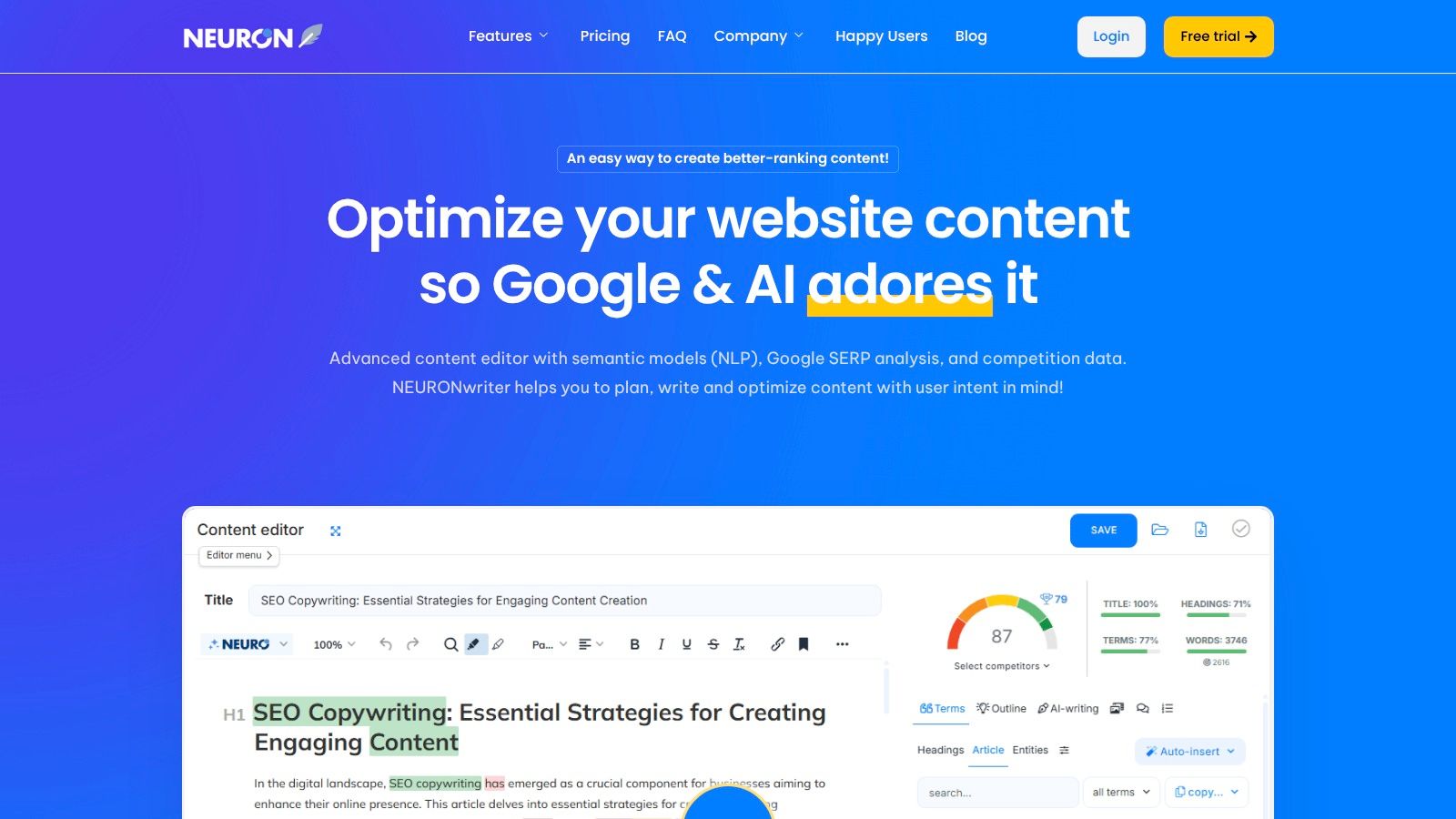
Key Features & User Experience
NEURONwriter’s core is its content editor, which gives you a real-time optimization score as you write. The interface is practical and straightforward, showing you recommended terms, headers, and NLP keywords in side panels. You can use its built-in AI to generate paragraphs, rephrase sentences, or expand on ideas directly within the editor, all while keeping an eye on your SEO recommendations.
Expert Opinion: SEO agency owner Mark Preston suggests, "Before you even start writing in NEURONwriter, spend a few minutes in the 'Competitors' tab to analyze their structure and content. You can often find gaps or common themes to leverage. Then, use the AI Outline generator to build a framework based on the best-performing H1s and H2s from the SERPs. It’s a huge time-saver."
The user experience is less flashy than some premium alternatives, but its focus on function over form makes it easy to learn and super effective.
Pros and Cons
- Pro: Excellent value, with generous plans suitable for solo users, freelancers, and small agencies.
- Pro: Combines semantic analysis, AI writing, and content planning into one cohesive tool.
- Con: The credit and analysis limits on lower tiers can be restrictive for high-volume content production.
- Con: The interface is more functional than visually appealing compared to top-tier competitors.
Pricing and Access
NEURONwriter offers several transparently priced tiers, from Bronze to Diamond, making it accessible for various budgets. The plans are often available through special lifetime deals on platforms like AppSumo, offering even greater value. Each tier provides a set number of content analyses and AI credits per month, with higher tiers catering to agency-level usage. Integrations with Google Search Console, WordPress, and Shopify are included, adding to its practical value.
Website: https://neuronwriter.com
10. Content at Scale
Content at Scale is built for one main purpose: to produce huge amounts of SEO-optimized articles quickly and efficiently. It's easily one of the best AI SEO tools for agencies, affiliate marketers, and businesses that need a predictable, high-volume content engine. The whole platform is like a streamlined factory for turning a list of keywords into fully-fleshed-out, optimized blog posts, complete with content briefs, plagiarism scans, and AI detection checks.
This focus on a production-line workflow makes it perfect for users who need to scale up their content without getting lost in the creative weeds for every single article. It's less of a multi-purpose toolkit and more of a specialized machine designed for a specific, high-demand job.

Key Features & User Experience
The user experience is centered around a simple, repeatable process: you put in your keywords, let the AI generate a draft, review and edit it in their optimizer, and then publish. The platform includes an editor that scores your content based on key SEO metrics, guiding you to make any necessary tweaks before the article goes live. For instance, you could upload 50 keywords on a Monday and have 50 solid, SEO-ready first drafts waiting for you by Tuesday. This system takes a lot of the guesswork out of on-page optimization.
Agency-focused features like white-labeling and specialized reporting are built right into the platform, allowing marketing firms to seamlessly integrate the tool into their client services.
Expert Opinion: According to high-volume publisher, Amy Bishop, "To get the best results from Content at Scale, you have to treat the AI's first draft as a solid starting point, not the finished product. Spend your time in the editor refining the introduction, adding your unique insights or brand stories, and ensuring the content perfectly matches user intent. The AI handles the heavy lifting, but you provide the final, crucial human touch."
Pros and Cons
- Pro: Designed specifically for high-volume content production, making it incredibly efficient for scale.
- Pro: Predictable credit-based pricing and agency features (like white-labeling) are a major plus for service providers.
- Con: Official pricing information is often gated or changes frequently, requiring direct contact or an in-app check.
- Con: It's a highly specialized tool; it lacks the broad keyword research or backlink analysis features of all-in-one suites.
Pricing and Access
Content at Scale operates on a credit-based system where users purchase a set number of "posts" per month. This model provides clear, predictable costs for content production. However, pricing tiers and specific details are often not publicly listed on their main site and may require signing up or speaking with their sales team for the most current information. This approach is common for tools targeting agency and enterprise clients with custom needs.
Website: https://contentatscale.ai
11. RankIQ
RankIQ has carved out a special place among the best AI SEO tools by focusing exclusively on bloggers and niche site publishers. Instead of offering a complex suite of features, it provides a super-focused, streamlined workflow designed to get you from a proven keyword to an optimized article as fast as possible. Its biggest selling point is the hand-picked library of low-competition keywords, which takes a ton of the guesswork out of the research phase.
The platform is built around a simple but powerful loop: you choose a pre-vetted, high-potential keyword from its library, generate an AI-powered content brief and outline, write your content, and then paste it into the content optimizer for a grade. This simplicity is its greatest strength, making it a fantastic choice for solo creators or small teams who need reliable results without a steep learning curve or feeling overwhelmed by data.
Key Features & User Experience
RankIQ’s user experience is clean and all about getting the job done. You pick a niche, and the tool shows you a list of keywords it has already analyzed for low difficulty and high traffic potential. From there, you run a "Content Report," which generates a comprehensive brief outlining key topics, related keywords, and what the top-ranking competitors are doing. For example, a blogger in the "home decor" niche can instantly access a list of vetted keywords like "boho living room ideas on a budget" and get a full report in minutes.
Expert Opinion: Brandon Gaille, the creator of RankIQ, often advises users: "Don't just rely on the overall content grade. Pay close attention to the 'Topics to Cover' section in the report. Ensuring you address these suggested sub-topics is often the key to outranking the competition, even if your overall score is slightly lower. Google wants comprehensive content."
The interface guides you from one step to the next, making it one of the most beginner-friendly tools on this list.
Pros and Cons
- Pro: A straightforward, blogger-centric workflow with pre-vetted keywords saves significant research time.
- Pro: Flat feature set across tiers; plans primarily differ by the number of monthly reports you can run.
- Con: Lacks the deep technical SEO, backlink analysis, and enterprise features of larger platforms.
- Con: Pricing and plan details are not transparently listed on the main site, often requiring you to go through the checkout process to see options.
Pricing and Access
RankIQ typically offers several pricing tiers based on the number of AI SEO reports you can run per month. The pricing structure is designed to be accessible to individual bloggers, with plans often starting around a competitive monthly rate. However, to see the specific plans and pricing, you generally need to visit the sign-up or checkout page, as they are not always publicly displayed.
Website: https://www.rankiq.com
12. G2
While it's not a tool you use for SEO, G2 is an essential research hub and one of the best AI SEO tools for discovery and comparison. Think of it as your trusted advisor. This B2B software marketplace lets you sort through hundreds of options, comparing them based on verified user reviews, feature sets, and pricing clues. For anyone trying to navigate the crowded and fast-changing world of AI SEO, it's an invaluable first stop.
The platform’s real power is in its structured data and real user feedback. You can filter tools for specific needs, read recent pros and cons from actual users, and even discover new categories like Generative Engine Optimization (GEO). This helps you get past the slick marketing and understand how these tools actually perform in the real world, making your decision-making process way more strategic and informed.
Key Features & User Experience
G2 provides detailed category pages for SEO, allowing you to do side-by-side comparisons of features and user satisfaction ratings. The interface is clean and built for efficient research, with powerful filters to narrow down your choices based on your company size, role, and specific features you need. The ability to click through to vendor sites to start trials directly makes the whole process smoother.
Expert Opinion: Every savvy software buyer knows this trick: "Don't just look at the overall rating on G2. Dive into the most recent reviews and filter by a company size that's similar to your own. A tool that's perfect for a large enterprise with a huge budget might be overly complex and expensive for a solo creator. Context is everything."
The user experience is straightforward, though it’s smart to be aware of sponsored placements which can influence which tools you see first.
Pros and Cons
- Pro: Excellent for side-by-side vendor comparisons and discovering niche or new AI SEO products.
- Pro: Access to recent, unfiltered user sentiment and reviews provides a realistic view of a tool's performance.
- Con: Some listings are sponsored, so always verify pricing and feature details directly on the vendor's website.
- Con: Marketplace listings may not always accurately reflect the latest free trial offers or credit systems.
Pricing and Access
G2 is completely free to use for research and comparison. You can create an account to leave reviews, but browsing and accessing all the comparative data doesn't cost a thing. Any pricing information you see on G2 is usually user-reported or supplied by the vendor, so you should treat it as a helpful guideline rather than an official quote.
Website: https://www.g2.com
Top 12 AI SEO Tools Comparison
| Tool | Core features | UX / Quality | Value / Price | Target audience | Unique selling points |
|---|---|---|---|---|---|
| Semrush | All‑in‑one SEO + AI content toolkit, audits, extensions | ★★★★☆ 🏆 | 💰 Mid‑High (paid toolkits) | 👥 Agencies, enterprise SEO teams | ✨ Integrated research→brief→write→optimize workflow |
| Surfer | SERP‑informed editor, audits, topical maps, AI Tracker | ★★★★ | 💰 Mid (add‑ons possible) | 👥 In‑house content/SEO teams | ✨ Strong on‑page guidance & AI visibility tracking |
| Clearscope | NLP term suggestions, scoring, briefs, AEO monitoring | ★★★★ 🏆 | 💰 High (credit‑based) | 👥 Editorial/content teams | ✨ Editorially friendly semantic & intent guidance |
| MarketMuse | Topic modeling, content inventories, AI briefs, authority metrics | ★★★★ 🏆 | 💰 Enterprise‑focused (tiers) | 👥 Strategy teams, enterprise publishers | ✨ Deep topical authority & gap analysis |
| Frase | Research → briefs → AI write → optimization, pay‑as‑you‑go drafts | ★★★★ | 💰 Budget‑friendly / PAYG options | 👥 Small teams, freelancers | ✨ Flexible pricing + buy optimized drafts without sub |
| Jasper | AI writing, brand voices, automation agents, templates | ★★★★ | 💰 Mid‑High (per‑seat) | 👥 Marketing teams, enterprises | ✨ Governance, brand voice & automation agents |
| Scalenut | End‑to‑end AI SEO, audits, GEO Watchtower, add‑ons | ★★★☆ | 💰 Competitive entry + modular add‑ons | 👥 SMEs, teams tracking AI search visibility | ✨ GEO/AEO visibility features for multiple engines |
| Writesonic | Multi‑model generation, optimization, GEO tracking, audits | ★★★★ | 💰 Mid (varied by plan) | 👥 Teams needing multi‑model access | ✨ Access to multiple LLMs (GPT‑4o, Claude, etc.) |
| NEURONwriter | Semantic SEO, AI editor, plagiarism checks, integrations | ★★★ | 💰 Budget‑oriented (transparent tiers) | 👥 Solo creators, small agencies | ✨ Good value semantic tooling + clear tiers |
| Content at Scale | High‑volume article production, briefs, plagiarism & AI checks | ★★★ | 💰 Mid‑High (credit/post‑credit) | 👥 Agencies, large publishers | ✨ Predictable scaling & white‑label reporting |
| RankIQ | Low‑competition keyword library, briefs, optimizer | ★★★ | 💰 Low‑Mid (blogger pricing) | 👥 Bloggers, niche publishers | ✨ Curated keywords & simple blogger workflow |
| G2 | Marketplace: listings, user reviews, pricing signals | ★★★★ | 💰 Free to use (links to paid vendors) | 👥 Buyers researching AI/SEO tools | ✨ Side‑by‑side discovery and user sentiment insights |
Making Your Choice: Which AI SEO Tool is Right for You?
So, we've walked through a powerful lineup of the best AI SEO tools out there, from all-in-one giants like Semrush to specialized content champs like Surfer and Clearscope. The journey through this landscape makes one thing crystal clear: AI isn't some sci-fi concept in SEO anymore; it's the engine driving modern digital strategy. The biggest takeaway isn't that you just need an AI tool, but that you need the right one for your specific goals, workflow, and budget.
The tools we've covered, like MarketMuse and Frase, show how AI can do the heavy lifting of data analysis, finding content gaps and topic opportunities that would take a human analyst weeks to spot. At the same time, platforms like Jasper and Writesonic have completely changed the game for content creation speed, letting even small teams produce high-quality drafts at a scale we've never seen before.
How to Choose Your AI SEO Co-Pilot
Feeling a little overwhelmed by the options? It gets a lot easier when you anchor your decision to what you actually need. Think of it like hiring a new team member. What specific job do you need them to do?
For the Solo Creator or Small Business Owner:
Your biggest challenges are probably time and money. Look for tools that give you the biggest bang for your buck and don't have a massive learning curve.
- Top Picks: Consider RankIQ for its super-targeted keyword lists or NEURONwriter for its fantastic value in content optimization. Frase also strikes a great balance of research and writing help in its starter plans.
- Implementation Tip: Start small. Focus on one core task, like optimizing your top 5 existing blog posts. Use the tool to find missing keywords and improve your content before you dive into generating brand-new articles from scratch.
For the Content Agency or Marketing Team:
You need tools that make collaboration easy, scale up content production, and deliver real results for your clients. Your focus is on efficiency, smooth workflows, and advanced features.
- Top Picks: Surfer and Clearscope are industry standards for creating high-ranking content and are great for team workflows. Scalenut’s "Cruise Mode" can dramatically speed up your content pipeline from keyword to finished draft.
- Implementation Tip: Build your chosen tool right into your content briefing process. Create standard templates based on the tool's recommendations and share them with your writers to keep quality and consistency high across all client projects.
For the Enterprise SEO or Large Corporation:
Your needs are complex. You're focused on large-scale data analysis, competitive intelligence, and showing ROI across massive websites. You need robust, all-in-one solutions.
- Top Picks: Semrush offers a comprehensive suite that combines traditional SEO metrics with a growing set of AI features. MarketMuse is a beast at enterprise-level content strategy, audits, and proving topical authority across thousands of pages.
- Implementation Tip: Start with a pilot project on one section of your website. Use the platform to do a full content audit and develop a strategy for a single product line or blog category. This will help you prove the tool's value before you roll it out company-wide.
Final Thoughts on Embracing the AI Revolution
At the end of the day, the best AI SEO tools aren't here to replace human strategy; they're here to amplify it. They automate the boring stuff, uncover data-driven insights, and free you up to focus on the creative, strategic work that really makes your brand stand out. The most successful SEO pros won't be the ones who fight this change, but the ones who learn to partner with AI effectively.
Your next step is to go from learning to doing. Revisit the tools on this list that really spoke to your challenges. Almost every platform offers a free trial or a limited free plan. Use this opportunity to test them out with your own keywords and on your own website. See which interface feels right and which insights give you the most immediate value. The perfect tool is out there waiting to supercharge your SEO efforts and help you claim your spot at the top of the search results.
Finding it hard to keep up with the latest AI trends and tools? At YourAI2Day, we do the research for you, delivering curated news, in-depth guides, and practical insights directly to your inbox. Stay ahead of the curve by visiting us at YourAI2Day and discover how AI is shaping the future of digital marketing and beyond.

